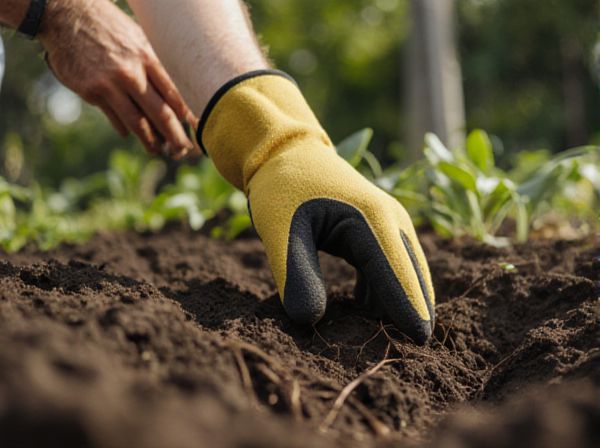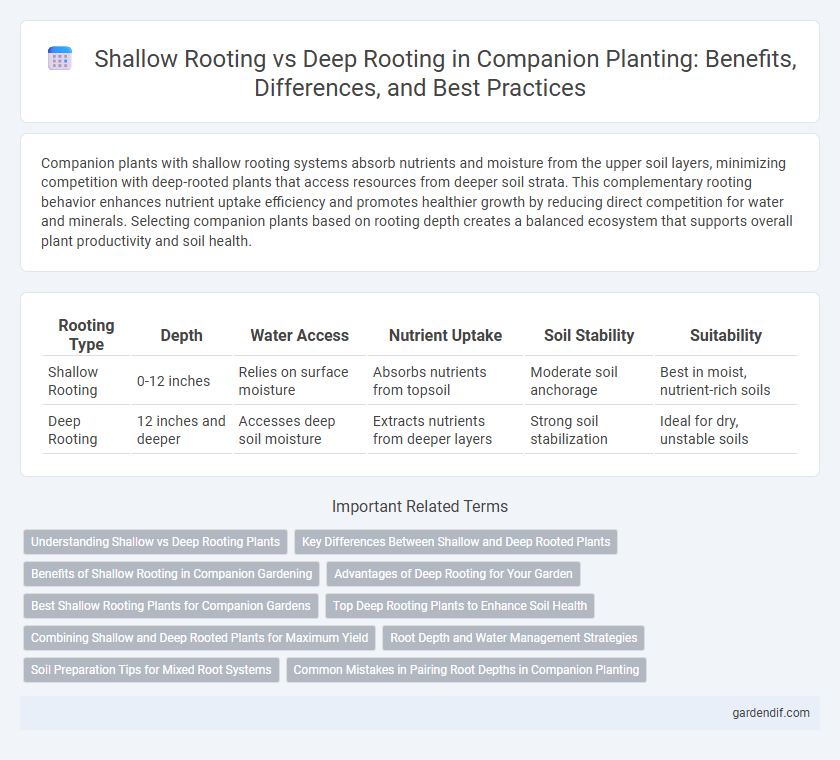
Shallow rooting vs Deep rooting Illustration
Companion plants with shallow rooting systems absorb nutrients and moisture from the upper soil layers, minimizing competition with deep-rooted plants that access resources from deeper soil strata. This complementary rooting behavior enhances nutrient uptake efficiency and promotes healthier growth by reducing direct competition for water and minerals. Selecting companion plants based on rooting depth creates a balanced ecosystem that supports overall plant productivity and soil health.
Table of Comparison
| Rooting Type | Depth | Water Access | Nutrient Uptake | Soil Stability | Suitability |
|---|---|---|---|---|---|
| Shallow Rooting | 0-12 inches | Relies on surface moisture | Absorbs nutrients from topsoil | Moderate soil anchorage | Best in moist, nutrient-rich soils |
| Deep Rooting | 12 inches and deeper | Accesses deep soil moisture | Extracts nutrients from deeper layers | Strong soil stabilization | Ideal for dry, unstable soils |
Understanding Shallow vs Deep Rooting Plants
Shallow rooting plants have root systems that spread widely near the soil surface, allowing quick access to surface water but limited drought resistance. Deep rooting plants develop extensive root networks that penetrate far below the surface, enhancing their ability to access deep soil moisture and nutrients. Understanding these root structures helps optimize plant selection for specific soil conditions and irrigation practices.
Key Differences Between Shallow and Deep Rooted Plants
Shallow-rooted plants typically develop roots within the top 6 to 12 inches of soil, allowing rapid absorption of surface water but limiting drought resistance. Deep-rooted plants extend roots several feet into the soil, enhancing stability and accessing nutrients and moisture from deeper layers during dry periods. These differences influence plant adaptability, water usage, and soil erosion control in various ecosystems.
Benefits of Shallow Rooting in Companion Gardening
Shallow rooting in companion gardening enhances nutrient uptake efficiency by spreading roots near the soil surface where organic matter is most concentrated. This rooting strategy also reduces competition for water and nutrients among plants, promoting healthier growth. Furthermore, shallow-rooted companions can improve soil aeration and reduce erosion, creating a more sustainable garden ecosystem.
Advantages of Deep Rooting for Your Garden
Deep rooting systems enhance garden stability by anchoring plants firmly in the soil, reducing the risk of uprooting during strong winds. They access deeper water reserves and nutrients unavailable to shallow-rooted plants, promoting drought resistance and robust growth. Deep roots also improve soil structure by creating channels that increase aeration and water infiltration, benefiting overall garden health.
Best Shallow Rooting Plants for Companion Gardens
Shallow rooting plants such as lettuce, strawberries, and marigolds are ideal companions in gardens because they preserve soil aeration and allow deeper-rooted plants to thrive without competition for nutrients. These plants improve pest control and pollination while maintaining soil moisture near the surface, enhancing overall garden productivity. Selecting shallow-rooting companions optimizes space and supports healthy plant development in companion gardening systems.
Top Deep Rooting Plants to Enhance Soil Health
Top deep rooting plants such as alfalfa, chicory, and daikon radish play a crucial role in enhancing soil health by penetrating compacted layers and improving aeration. These plants facilitate nutrient cycling and increase water infiltration, promoting a more resilient soil ecosystem. Incorporating deep rooting companions can significantly boost organic matter content and support sustainable agricultural practices.
Combining Shallow and Deep Rooted Plants for Maximum Yield
Combining shallow-rooted and deep-rooted companion plants enhances nutrient uptake by accessing different soil layers, reducing competition and improving overall soil health. This synergy promotes maximum yield by maximizing resource utilization, with shallow roots extracting surface nutrients and deep roots bringing up water and minerals from deeper layers. Such strategic planting optimizes root structure diversity, increasing resilience against drought and improving soil aeration.
Root Depth and Water Management Strategies
Shallow rooting systems enable plants to quickly absorb surface moisture but require frequent watering to prevent drought stress, making them suitable for regions with regular rainfall. Deep rooting enhances access to groundwater by penetrating deeper soil layers, supporting sustained water uptake during dry periods and improving drought resilience. Efficient water management strategies involve matching root depth characteristics with irrigation practices to optimize water use and promote plant health.
Soil Preparation Tips for Mixed Root Systems
Shallow rooting plants benefit from loose, well-aerated topsoil that prevents compaction and enhances nutrient absorption, while deep rooting species require deeper soil layers to encourage extensive root growth and stability. For mixed root systems, stratify soil preparation by incorporating organic matter and sand at varying depths to accommodate diverse root depths and improve moisture retention. Tailoring soil texture and fertilization at multiple layers ensures optimal growth for both shallow and deep-rooting companions, promoting harmonious root development and overall plant health.
Common Mistakes in Pairing Root Depths in Companion Planting
Common mistakes in pairing root depths in companion planting include mixing shallow-rooted plants with deep-rooted companions that compete excessively for nutrients and water, leading to stunted growth. Gardeners often overlook the root architecture of plants like lettuce (shallow-rooted) and tomato (deep-rooted), resulting in inadequate resource allocation. Proper understanding of root zone compatibility optimizes nutrient uptake and minimizes root competition, enhancing overall plant health.
Shallow rooting vs Deep rooting Infographic

 gardendif.com
gardendif.com